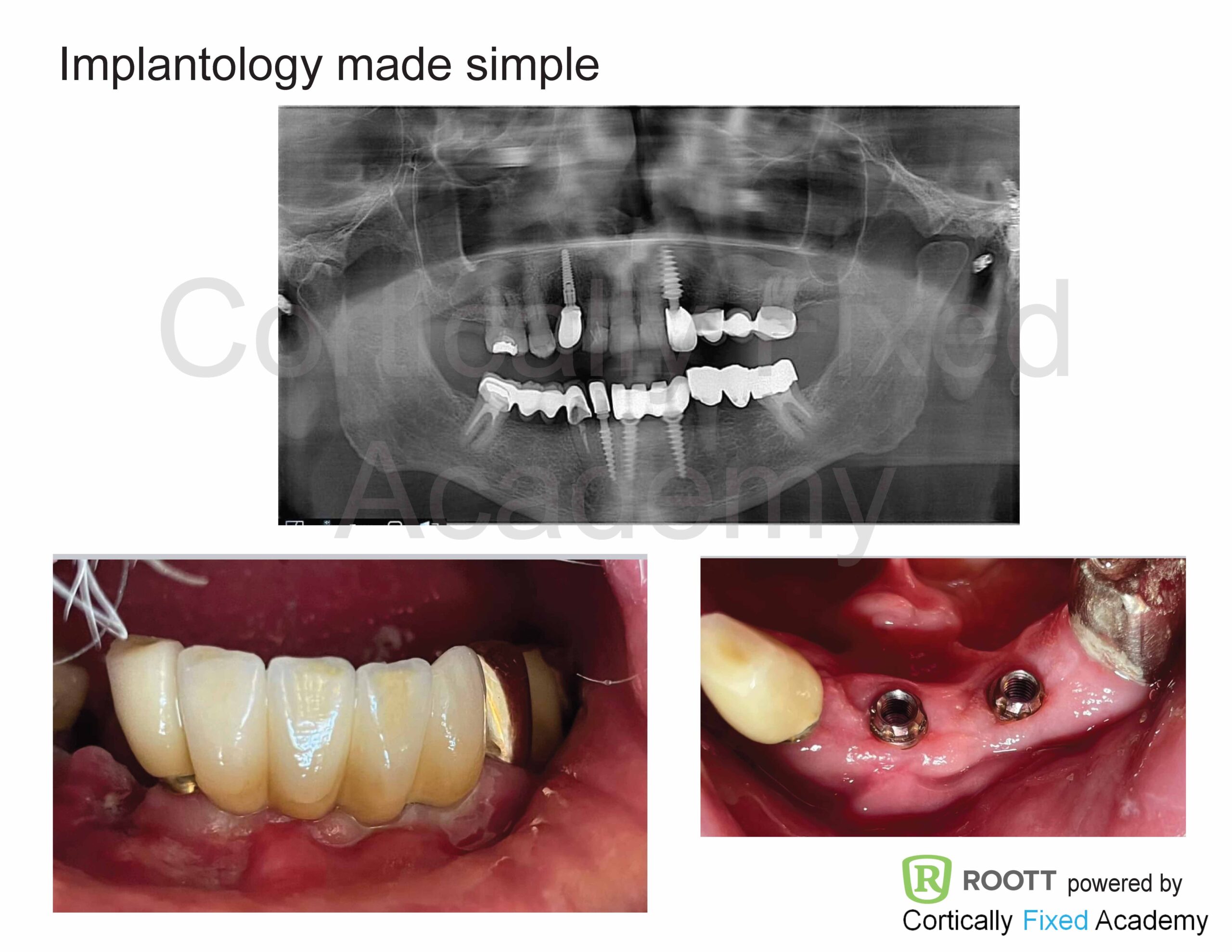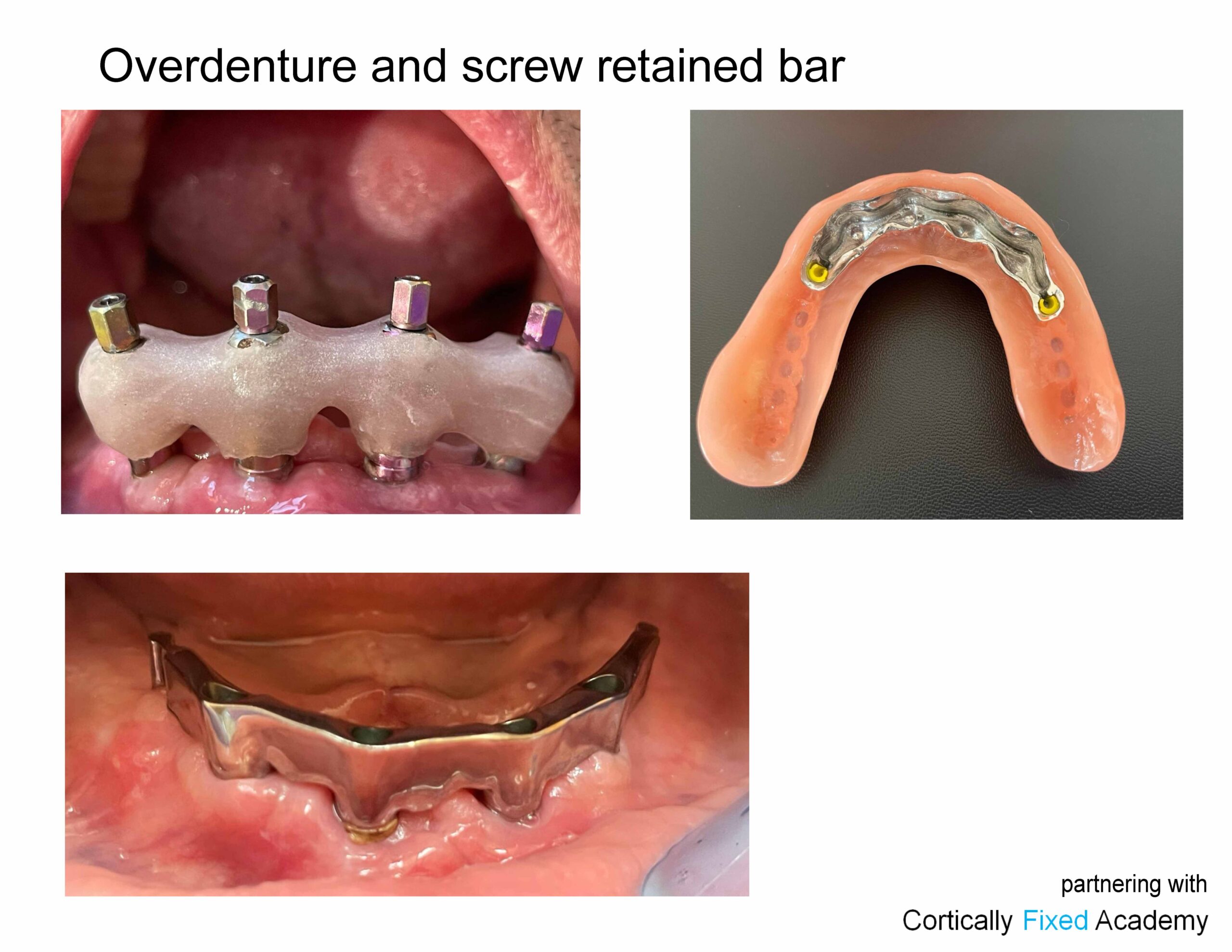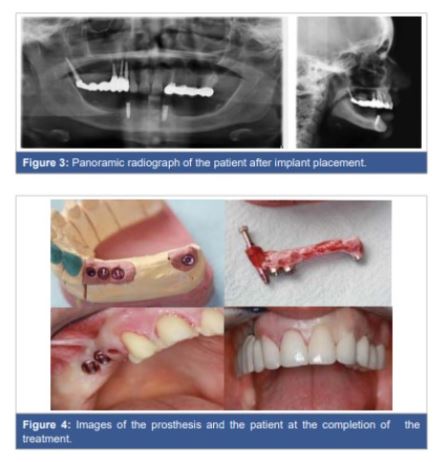Patient Case Reports
Documented Patient Cases with ROOTT Implants
ROOTT implants offer treatment protocols that may not be possible with the traditional 2 piece implants. The cases documented also demonstrate the use of Minimal Invasive Implant Dentistry (MIID) simplifying procedures for practitioners and offering comfort to the patient.
Minimally invasive implantology
Case Reports – Feb 2025
Treatment option in the atrophied maxilla using ROOTT P (Pterygoid) offering strong osteofixation . High torque of 50N + allowing for immediate loading.
Early loading with patient receiving screw retained final metal ceramic bridge after just 3weeks. Metal ceramic screw retained.
Happy patient.

Implantology made simple
Minimal invasive.
Case Reports – July 2024
Patient with a small crest, to avoid bone graft treatment option wat to use one piece tissue level implants.
Implants were placed flapless with minimum pain. Patient received a screw retained bridge 2 weeks later.



Bone Truss Bridge (BTB) approach minimal invasive.
Case Reports – July 2024
Immediate loading by Bone Truss Bridge (BTB) approach using ROOTT P compressive implant. Patient wanted fixed teeth in minimal invasive treatment. Remaining teeth were extracted and implants placed. 2 weeks later the patient received a fixed metal resin bridge.



Failed Sinus and Tissue level implants – Pterygoid Implants (No sinus lift)
Case Reports – May 2024
Patient attended the clinic with a failed sinus lift on her right side, the bone volume was also poor. One piece tissue level ROOTT S3514 and S3508 were placed bridged with Pterygoid Implant. On the left side bone volume was good and traditional 2 piece implants were placed. Delayed loading in both cases. Minimal Invasive = happy patient.




Minimal Invasive treatment option in the atrophied bone with overdenture
Case Reports – Apr 2024
Treatment option in the atrophied bone with overdenture and screw retained barre. The bone conditions were not optimal as there was a very narrow crest.
Treatment option was to use tissue level implants – screw retained by open flap. Compression and primary stability were high allowing Practitioner to deliver the patient definitive prosthetics after 3 weeks.



Treatment option with ROOTT R (two piece with multi-unit) & ROOTT M (tissue level)
Case Reports – Mar 2024
Treatment option with overdenture and screw retained barre in the mandible and maxilla. In the mandible M implants were used and loaded immediately. In the maxilla ROOTT R implants R3512 with multi unit were used with delayed loading after 3 months



Treatment option with ROOTT R,P & M
Case Reports – Feb 2024
Maxilla was originally done in 2021 by immediate loading and mandible was done in 12/2023 by delayed loading using ROOTT R and ROOTT M implant
The Prosterior part 36, 37 was done prior to 2020



72 Year old with broken bridge and bone defect
Case Reports – Jan 2024
The patient a lady of 72 years broke her bridge in the anterior area.
Treatment option was surgery with ROOTT C (One Piece) and ROOTT P (Pterygoid Implant). The big defect was fulfilled with bone graft material. 2 weeks later a ceramic was placed, cemented and screw retained.


Early loading with Pterygoid implants in soft bone. Metal ceramic bridge
Case Reports – Jan 2024
The patient of 55 years old was wearing a total prosthesis, he was very unhappy and retention was bad.
Treatment option was surgery with ROOTT P (Pterygoid Implant) as the bone was soft, D3 cancellous bone, temporary bridge, impression after surgery, key, try-in of the frame and placement. All screw retained with angulated screw channel.



Minimally invasive approaches to Maxillary Atrophy with metal bar and denture.
Case Reports – Dec 2023
The patient a man of 70 years old unhappy with the no retention with his total prosthesis.
Bucally there was not enough bone to place a normal implant. Option was to consider bone grafting, the patient had specifically requested he did not wish to have a bone graft. The option was to place one piece tissue level implants M3016 by delayed loading. After 4 months the patient received a overdenture on a screw retained milled bar.



Minimally invasive approach to Maxillary Atrophy. Case report featuring fixed screw retained bridge and tissue level implants
Case Reports – Oct 2023
Atrophy of the maxilla poses significant challenges to dental rehabilitation, particularly in the context of dental implant placement. There are a number of approaches from invasive techniques such as zygomatic implants, sinus grafting, and bone grafting, to more minimal invasive methods utilizing pterygoid implants and the transnasal approach. The latter techniques are interesting due to their potential for early loading, where patients can receive a fixed rehabilitation within 2-3 weeks post-operatively.
The patient a lady of 56 attended clinic with periodontal problems. After intra oral examination and radiological reviews, it was observed that the width and height of alveolar bone is not enough for classic implant placement. On the first appointment all teeth in the maxilla were extracted, and implants were placed, under local anesthesia. Pterygoid Implants C 3.5/20 mm were placed in position 18 and 28 to get a high primary stability, same implants were used at the extraction’s sockets and in the rest of the maxilla.
A metal ceramic bridge was fabricated after frame try-in. Three weeks after the beginning of the treatment, the gum has healed nicely, bridge was screw-retained READ MORE



Minimally invasive approach to Maxillary Atrophy. Case report featuring Tissue level implants
Case Reports – Oct 2023
There exist numerous approaches to manage such scenarios, ranging from invasive techniques such as zygomatic implants, sinus grafting, and bone grafting, to more minimal invasive methods utilizing pterygoid implants and the transnasal approach. The latter techniques are interesting due to their potential for early loading, where patients can receive a fixed rehabilitation within 2-3 weeks post-operatively.
The patient a lady of 53 had advanced periodontitis which made her came several times to the clinic for emergency treatment of pain. At a point patient wanted a permanent solution to this problem. Surgery was done in one session under local anesthesia, teeth in the maxilla and mandible were extracted and implants were placed.
Three weeks after initial consultation, patient ́s mouth was rehabilitated with definitive metal ceramic bridges. This was made possible due to the achieved bicortical anchorage in the anterior part and a strong cortical anchorage at the pterygoid plates (75 N/cm) in the maxilla, these anchorage ensured high primary stability which encourages immediate loading READ MORE



Minimally invasive treatment option in the Atrophied Mandible
Case Reports – Sep 2021
ROOTT M implants are a new generation of implants manufactured by TRATE (Switzerland). The Implants have been specifically developed for different locations in the jaw, they have also facilitated flapless and immediate loading.
The one-piece implants have no other components needed except a fixation screw for attachment to prosthesis. The special compressive thread produces compression when inserted into the cancellous bone, creating a layer of cortical bone around the implant which allows immediate loading with high primary stability. The absence of intrinsic micro gaps helps avoid peri-implantitis. READ MORE

Rehabilitation of Atrophic Maxilla using Pterygoid Implants
Case Reports – Jan 2018
Restoration of a severely atrophic jaw presents a challenge in dentistry. The poor bone quality of the posterior maxilla, coupled with limited vertical bone height due to sinus pneumatisation and chronic periodontitis often leaves insufficient bone for implant anchorage [1,2]. READ MORE

Implant Treatment Options in A Compromised Bone using Prosthesis Retained by Screws and Cement
Case Reports – Nov 2020
Cement retention is often considered to be the most successful method by reducing stress in the restoration and bone, excess cement application leading to bone loss and peri-implant disease are major issues. Patient dissatisfaction due to repeated loosening of the prosthesis cause by debonding is also a major issue in cement only retained restorations.
Screw-retained restorations allow for easier removal and access for maintenance, however, achieving a passive fit is significantly more difficult to attain with a screw-retained restoration due to stress introduced into the restoration through the tightening of screws.
The dual retained restorations ( i.e. screw and cement retained restoration) combine the advantage of both screw and cement retained restorations. A thin layer of the cement reduces stress in the restoration and also compensate for any minor discrepancies in the fit. Further Cement-retained restorations reduce stress and the likelihood of stress related implant failure or peri-implantitis. The use of temporary cement makes restoration removal easier.

An alternative treatment option in the Atrophied Maxilla without Sinus Lift and Bone Graft
Case Reports – March 2020
Extremely resorbed alveolar bone with insufficient height (10mm) and width (6mm) for conventional implant placement, the insufficient space between adjacent edentulous teeth for the use of conventional implant, or the presence of neurovascular bundles that may make implant placement impossible are but to mentioned few of these reasons. READ MORE

Minimal treatment options with
One-Piece Implants
Case Reports – March 2020
One Piece implant is also called monobloc implant. A
monobloc implant is a set of dental implants comprising an
implant body and a part forming a post stem, the different
implants may have different angles between the implant body axis and the post stem axis, the implant bodies are designed to be ϐixed in the mandibular or maxillary bone. It may have a built-in abutment as seen in the Compressive Implant from ROOTT (TRATE) or the abutment may be screwed to the implant as seen in the compressive multi-unit from ROOTT (TRATE) or the tissue level implant from STRAUMANN.
One of the major changes seen in the one-piece implant by
ROOTT is the special neck design that allows the angulation of
the implant to correct the implant axis when it is needed. This
is considered as a major change because it corrects the major
disadvantage of the one-piece Implant. READ MORE

